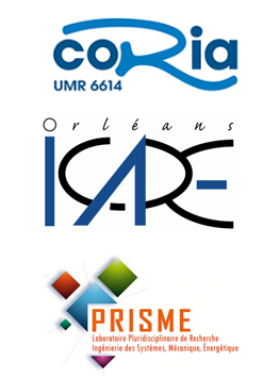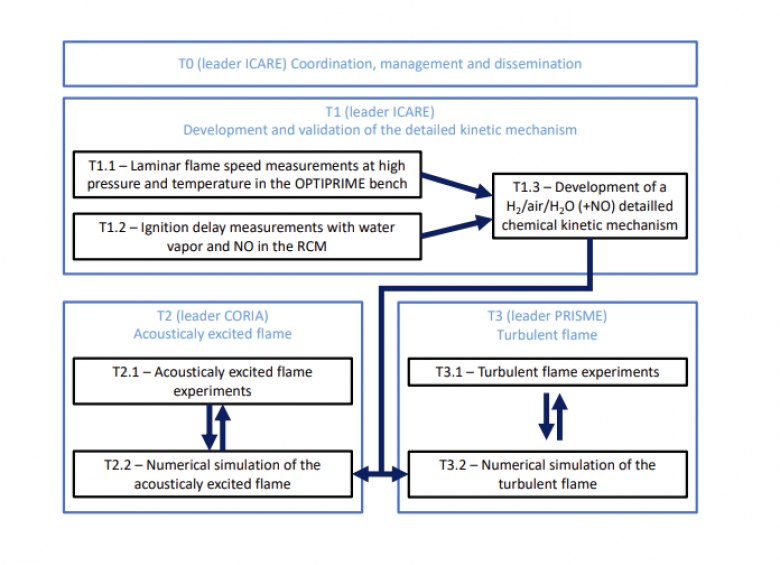Use of hydrogen as a low-carbon energy source for propulsion applications.
|
Project supported by the National Research Agency |
|
| Duration► | 48 months |
| Start ► | October 2021 |
| ANR funding ► | 595k€ |
Context
Reducing our impact on climate change means reducing our consumption of fossil fuels. The EU aims at being climate-neutral by 2050 – an economy with net-zero greenhouse gas emissions and zero pollutant emissions. As a result, the use of hydrogen as an energy carrier is currently seen as an unmissable option. For example, conventional vehicles using internal combustion engine (ICE) technology for gasoline and diesel are now gradually being replaced by hydrogen fuel cells (FC) and electric vehicles (battery). However, this strategy raises questions given its massive use of rare materials.
An alternative is the direct injection and combustion of hydrogen for heavy duty vehicles. Advantages over FC technology include a higher tolerance to fuel impurities, the flexibility to switch between different fuels, a reduced use of rare materials, particularly for heavy-duty trucks as well as gas-turbines. However, there are a number of practical drawbacks associated with the very low energy density of hydrogen.
A major drawback is that hydrogen requires a small amount of energy for its ignition. Combustion can then easily be initiated by hot spots or residues in the combustion chamber, which can lead to pre-ignition and knocking in ICEs, prejudicial to the proper functioning of the engine. Another drawback lies in the adiabatic flame temperature of hydrogen at equivalence ratios greater than 0.5 which is relatively high, and promotes the formation of nitric oxides (NOx).
Remediation based on dilution with steam or nitrogen then becomes mandatory, in an attempt to reduce combustion temperature. Finally, the mass diffusivity of hydrogen being the highest of all fuels, the stability of the resulting flame and the NOx emission are greatly affected by thermodiffusive effects, which makes the design of an efficient injector and combustion chamber challenging. These fundamental behaviors have been relatively little studied even though these are key elements in the development of hydrogen technology.
Objectives
The project SPEEDYH is an academic project aiming at the scientific fundamental understanding of hydrogen/air combustion with steam dilution and Exhaust Gas Recirculation (EGR). This will be achieved through experimental measurements and numerical modelling. Experimental and numerical database from SPEEDYH will be made available to the scientific community and will also benefit to the industrial community (aerospace, automotive, chemistry, etc.) as industry needs validated knowledge to deeply understand and control the process they develop while respecting emission regulations (NOx).
Indeed, with the use of hydrogen, how are the design rules changed? How is NOx production affected and then modeled under real engine operating conditions? Are the numerical models commonly used for the combustion of natural gas directly transposable? These open questions on fundamental aspects of H2/air combustion will be studied within the framework of the project SPEEDYH through well-defined experiments completed by high-fidelity numerical simulations.
Partners
► CORIA COmplexe de Recherche Interprofessionnel en Aérothermochimie.
► ICARE Institut de Combustion, Aérothermique, Réactivité et Environnement.
► PRISME laboratoire Pluridisciplinaire de Recherche, Ingénierie des Systèmes, Mécanique, Energétique.
Work Plan
The study is organized into 4 tasks, 3 of which are dedicated to scientific and technical work :
- Coordination and management (ICARE)
- Development and validation of the detailed kinetic mechanism (ICARE)
- Acousticaly excited flame (CORIA)
- Turbulent flame (PRISME)
Contact : Fabrice Foucher ⇒ fabrice.foucher@univ-orleans.fr)



